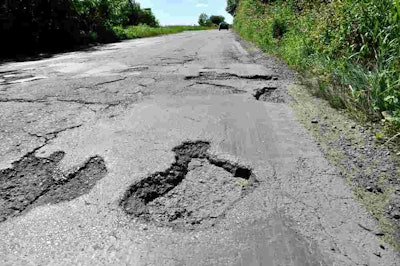
Here in the Rust Belt, the season of snow and ice is giving way to the season of rain and potholes which is just a brief transition to the season of road repairs and endless traffic backups.
My personal belief is that we need the pavement ruptures to cause the construction and traffic delays so that we will be happy to see winter arrive, but that is another story.
Barring a bridge collapse or some equal disaster, the pothole season is generally the only time of year that motorists and taxpayers hereabouts talk about the problems with our roads. Since we can’t talk about paying more taxes to build and maintain roads — this is America, after all, and we’re entitled to free roads — the conversation usually turns to some variation on “why are our roads so crappy?”
The most popular public notions I hear include government corruption, government mismanagement, lazy employees (many motorists believe traffic flaggers at construction zones have easy jobs and work for the government), and the use of cheap materials and/or engineering designs.
The question of concrete versus asphalt is coming up more often in my reading material and conversations, perhaps an outgrowth of the marketing initiatives of advocates for those materials. It is a seductive scenario in a society that prefers to solve problems with the downing of a pill or the implementation of a simple solution: All we have to do is build all our roads with (pick one) asphalt or concrete and we’ll never have another pothole.
But the pothole season in the Chicago metro paradise I call home is an equal opportunity destroyer of pavements. The aging asphalt residential streets I use on my weekly errands are dotted with potholes, some tiny, some 6 inches deep. The concrete secondary road that leads to my subdivision, now somewhere in its second decade of life, has been tormented by freezes and thaws and perhaps a less than ideal sub base and now produces the ride quality of a logging road, with mismatched panels and deepening cracks at the seams.
 [email protected]
[email protected]My friends and relatives are disappointed when I share this with them, and add that the great advances in pavement quality and longevity in the last quarter-century have mostly evolved from the freedom of engineers to design pavements for the specific, mile-by-mile conditions they must endure — traffic volumes, wheel loads, soil conditions, temperature extremes, and precipitation levels — and to select designs and materials based on system-wide budget realities.
Our problem in this, the season of rain and potholes, is not concrete or asphalt. It is not the work of our highway professionals or our contractors. It is the lack of priority the public has for roads and bridges. We would like to have roads that last 50 to 100 years, and they can be built out of concrete or asphalt or both. But those roads cost money, a lot more money than we the people and our chosen representatives have ever been willing to pay for roads.












